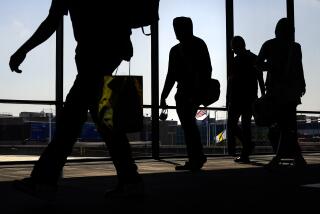Asia’s Once-Buoyant Airline Industry Reeling
- Share via
HONG KONG — While airlines around the world battled insolvency and fretted over the war in Iraq, Asian-based carriers rode out the industry’s latest downturn a bit more smoothly. Then along came SARS.
Asia’s aviation industry has been pitched into what some are calling its worst crisis ever, with thousands of flights canceled, passengers scared to fly and those who do fly facing delays in some airports as they undergo mandatory checks for fever or symptoms of severe acute respiratory syndrome, or SARS.
An executive at Hong Kong’s Cathay Pacific Airways recently warned that the carrier was hemorrhaging $3 million a day and might have to ground its entire passenger fleet next month if traffic kept falling. Cathay quickly tried to back away from such a dire warning but admitted it may have to consider further cuts on top of the 42% of its fights already canceled for now.
Analysts say it’s impossible to know how badly the industry will be hit.
“The best scenario is two months of pretty severe pain, and the worst scenario is, well, your guess is as good as mine,” said Peter Harbison, managing director of the Center for Asia-Pacific Aviation, based in Sydney. “It depends on what happens with SARS.”
As the SARS crisis escalated last month, the World Health Organization noted with alarm that the disease was spread by air travelers and then dealt Hong Kong a heavy blow as it advised people to stay away from the former British colony for now.
Cathay Pacific and Dragonair have cut back operations so severely that the Airport Authority that runs Hong Kong’s Chek Lap Kok airport warned that its core business was threatened.
Other regional carriers are slashing costs as they try to wait out the storm, while U.S.- and European-based carriers are trying to minimize damage with quick cuts in flights to the worst-affected regions.
Continental Airlines, based in Houston, has scrapped its five-times-a-week nonstop services between Hong Kong and New York but says planes will take off again starting June 4.
“Hong Kong is a financial hub and New York is a financial hub. The demand is huge,” spokeswoman Bessy Hui said. “Corporate clients are just postponing their trips. We see it as a temporary suspension.”
The other U.S. carriers serving Hong Kong are United Airlines, which is operating under bankruptcy protection, and Northwest Airlines. They’ve also been cutting back
Eagan, Minn.-based Northwest Airlines cut capacity by 12% on March 21 due to the war in Iraq and canceled three flights -- two round trips from Tokyo to Hong Kong and an Osaka-Honolulu round trip -- due to the war and SARS.
United announced a 12% cut in its flight schedule for next month on top of an 8% cut for April, suspending a total of 105 U.S. and 24 international flights as of May 5. Cuts on routes to Hong Kong, Tokyo, Taipei, Singapore and Sydney were due to the sharp drop-off caused by the spread of SARS, it said.
Despite the major troubles SARS is handing Cathay Pacific, analysts said the carrier remains strong. It got a boost Thursday when route-licensing officials here said it could resume services into China after more than a decade out of the growing market. Dragonair, partly owned by Cathay, had fought hard against the proposal.
A downturn like the one now hitting the industry could cripple a weaker airline. But with stable freight traffic and cash reserves of about $1.74 billion, Cathay Pacific “is very strong,” said Richard Stirland, director general of the Assn. of Asia Pacific Airlines, based in Kuala Lumpur, Malaysia. “It’s got a minimal debt load compared to other airlines around the world.”
Mainland Chinese carriers, in the midst of a government-mandated restructuring, have been only partially sheltered from SARS by their limited reliance on international routes.
Shanghai-based China Eastern Airlines said last week it was cutting flights to Hong Kong and Japan by 30%, and shifting aircraft onto domestic routes that company secretary Luo Zhuping hopes can be sustained. China Eastern has seen an “obvious drop” in traffic to Hong Kong and the United States and other overseas destinations, Luo said.
Elsewhere in Asia, Japan Airlines saw its group tour business dry up virtually overnight as travel agencies canceled tours to China following the WHO and government warnings, company spokesman Geoff Tudor said.
JAL has diminished hopes for the “golden week” national holidays coming up in early May.
“This year, it’s not going to be a ‘golden week,’ ” Tudor said. “On an Olympic scale, it’s more going to be a ‘bronze week.’ ”
Singapore Airlines, which has its own local SARS outbreak to contend with, last week cut 206 trainee jobs and reduced flights for the third time in as many weeks.
In Vietnam, which also has been hit by SARS deaths and restrictions on its travelers in some countries, the director general of Vietnam Airlines, Nguyen Xuan Hien, predicted a 25% drop in passengers this quarter.
More to Read
Inside the business of entertainment
The Wide Shot brings you news, analysis and insights on everything from streaming wars to production — and what it all means for the future.
You may occasionally receive promotional content from the Los Angeles Times.










